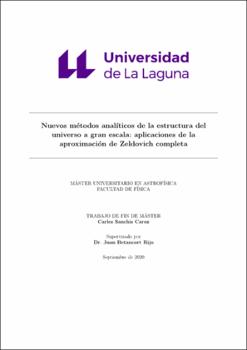Nuevos métodos analíticos de la estructura del universo a gran escala: aplicaciones de la aproximación de Zeldovich completa
Autor
Sanchis Caroz, CarlesFecha
2021Resumen
The structure formation in the universe is a subject of a great interest since last century and
it is directly linked to the evolution of the universe. During this time different models have
been proposed and nowadays the paradigm is that quantum density fluctuations grew since the
inflationary epoch until they become non-linear and are virialized. These initial fluctuations are
described by the Harrison Zeldovich power spectra which is modified by some physical effects
until the separation between radiation and matter at the moment of recombination (z = 1100).
From that moment on only gravity affects these fluctuations increasing their amplitude but not
modifying the shape of power spectra. The radiation escaping at recombination which is observed now reflects the fluctuations at that moment and it allows us to determine that the cold dark
matter (CDM) is necessary to explain the acceleration of the growth of the barionic fluctuations.
The consideration of the CDM, that produces the bottom-up formation of the structures, and
the accelerated expansion of the universe leads to the ΛCDM model.





